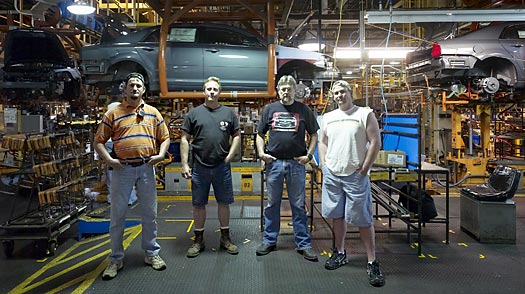Bailout Watch 577: Auto Task Force Redlines GM Production
The WSJ reports that GM has added a third shift to its Fairfax assembly plant at the request of the US auto task force. The Kansas City plant will now build 6,300 vehicles a week working 21.6 hours a day, up from 4,500 units per week working 14.5 hours per day with two shifts. The move reportedly makes Fairfax the first US auto plant to run three shifts on a routine basis. According to the WSJ,
the auto task force that oversaw GM’s reorganization last spring was startled to learn that the industry standard for plants to be considered at 100% capacity was two shifts working about 250 days a year. In recommending that the government invest about $50 billion in GM, the task force urged the company to strive toward operating at 120% capacity by traditional standards.
Why? That’s not exactly clear. The potential downsides of the move are far easier to identify.
One of the biggest downsides to running a production line almost 24 hours a day is that it reduces time for maintenance and restocking. The WSJ notes that Toyota’s US plants only runs third shifts on a temporary basis, as Mike Goss, a spokesman for Toyota’s U.S. manufacturing operations, explains “two shifts gives us the flexibility to perform any necessary maintenance on equipment between shifts.” Paint shops, for example, take about 4 hours per day of cleaning and maintenance according to plant efficiency analyst Ron Harbour. If production schedules don’t include that time for maintenance, it can leave the rest of the line idling, the bane of any production system. “If running three shifts means you’re moving [the line] at only 60% of capacity, then you haven’t gained anything,” says Harbour.
Such inefficiencies are bad enough on their own, but because GM has to offer third-shift jobs to existing UAW members and pay $30k per worker to move them to Kansas City, the costs add up quickly. And that’s before you factor in the fact that midnight-shift workers unsurprisingly have above-average rates of on-the-job errors, absenteeism and illness. Or the fact that strong sales of the Malibu and LaCrosse assembled at Fairfax are hardly a sure thing (especially if quality declines), opening the possibility of more incentive-driven inventory clearing if the market stays weak (or quality declines). For all these reasons, automakers typically add overtime to the standard two shifts rather than routinely running plants around the clock.
But when the government owns you and it asks you to add a third shift, you do it. “Do those guys understand the business?” wonders Harbour of the auto task force. Apparently not so much. The upsides are nebulous and far from guaranteed, while the downsides couldn’t be more clear. The fact that the decision was made by the government, which has already admitted that it is not interested in maximizing the value of its (our) 61 percent stake in GM, raises (yet again) the specter of moral hazard. And if the gambit doesn’t pay off, the consequences could be huge, since Fairfax is only the start. In the second quarter of next year, GM will add third shifts to its Fort Wayne Silverado plant, and its Delta Township Crossover plant as well.
More by Edward Niedermeyer
Latest Car Reviews
Read moreLatest Product Reviews
Read moreRecent Comments
- V8fairy Not scared, but I would be reluctant to put my trust in it. The technology is just not quite there yet
- V8fairy Headlights that switch on/off with the ignition - similar to the requirement that Sweden has- lights must run any time the car is on.Definitely knobs and buttons, touchscreens should only be for navigation and phone mirroring and configuration of non essential items like stereo balance/ fade etc>Bagpipes for following too close.A following distance warning system - I'd be happy to see made mandatory. And bagpipes would be a good choice for this, so hard to put up with!ABS probably should be a mandatory requirementI personally would like to have blind spot monitoring, although should absolutely NOT be mandatory. Is there a blind spot monitoring kit that could be rerofitted to a 1980 Cadillac?
- IBx1 A manual transmission
- Bd2 All these inane posts (often referencing Hyundai, Kia) the past week are by "Anal" who has been using my handle, so just ignore them...
- 3-On-The-Tree I was disappointed that when I bought my 2002 Suzuki GSX1300R that the Europeans put a mandatory speed limiter on it from 197mph down to 186mph for the 2002 year U.S models.


































Comments
Join the conversation
After giving notice to eliminate the 3rd shift at Chrysler's Windsor Assembly in March of this year, the decision was reversed in July, presumably by the Auto Task Force. There wasn't then and there isn't now a business case for the continuation of the over production. Sales continure to fall and the plant continues to build more vehicles than it sells and believe it or not, has just boosted production again. Successful businesses don't operate this way, but wards of the state do.
Seems to me only demand should warrant increasing production. This sounds arbitrary and ill advised.Where is the great increased demand for the production of 3 shifts? "The Kaisers never retrench !" Henry J Kaiser's retort to partner Joe Frazer's suggestion that K-F pare back the building of cars to meet the lowered demand, increased competition [fresh designs from the Big 3] and the cooling of the post war sellers market. Or in GM's case: "Ramming speed!!!!!!!" Maybe the auto task force is using the increased production to make sure all rural areas are supplied with vehicles......